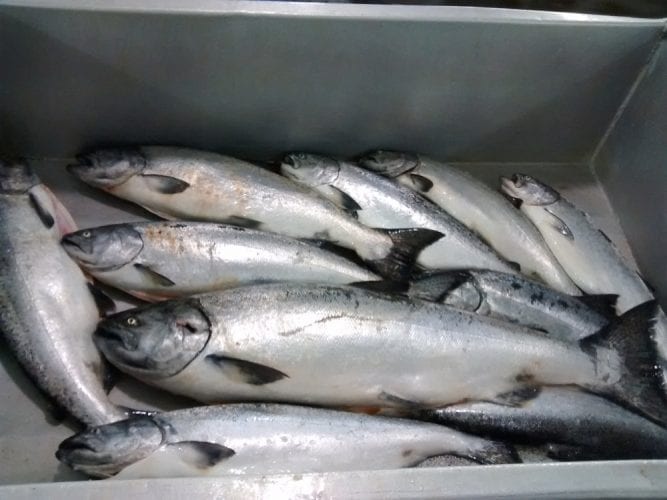Southeast Alaska’s commercial salmon trollers open their summer season for king salmon July 1st with a harvest target of 53,800 Chinook. The fleet is expected to catch that in a short opening. That’s after low catches and restricted fishing for kings this spring.
The first summer opening is expected to last four or five days and will be managed in-season. That means the Alaska Department of Fish and Game will announce a closure once the catch nears that harvest target.
Grant Hagerman is the department’s troll management biologist for Southeast and says fishing in the spring season has been slow.
“The catch rates in a lot of these areas have been low, you know in the sport fisheries as well, what we’re seeing on the outside is very low catch rates, not necessarily limiting out every day, even with a much reduced bag limit,” Hagerman said. “So we’re seeing truly that the abundance of fish is looking to be down. And so that’s kind of the anticipation moving into our July fishery, that’s what we’re expecting as well, is to see some catch per fleet per day is what we use in the July opening to kind of gauge when to close the fishery, expecting that to be much reduced compared to what we’ve seen compared to last year or even the last five years.”
This year’s winter season was shut down early and the spring season was limited to areas near Alaska hatcheries and on the outer coast. Those restrictions aimed to conserve kings returning to spawn in Southeast rivers. Some Chinook stocks are experiencing record low returns following several years of poor survival in the ocean.
In addition to the limited fishing time and area, the catch itself this year is reduced, by ten percent across all fishing gear groups.
While the numbers of fish have been historically low, prices paid at the docks have hit unprecedented highs. The spring season price peaked at nearly 13 dollars a pound but dropped to closer to 10 dollars a pound near the end of the season.
Because of the restrictions this spring Hagerman said the number of trollers out fishing has been low.
“There are basically just several ports that have had spring troll opportunities near them, in Ketchikan and in Craig, in Sitka and in Yakutat,” Hagerman explained. “So for some trollers it’s difficult to make that move to these areas to fish and so it’s definitely reduced effort. But then you know the fishing has not been great. As I mentioned May has been slow and even here in June which is normally the peak of abundance of all stocks that are passing through the areas, has not been, they have not been really high catch rates, so that I think dissuades some of the trollers from going out as well.”
Although spring fishing targets Chinook produced at Alaskan hatcheries, trollers will still intercept around four thousand treaty kings – or fish produced outside the state. Catches of those fish are governed by the Pacific Salmon Treaty between the U.S. and Canada. That agreement along with estimates of the abundance of kings drives what Alaskan trollers are allowed to catch each year.
With low catch totals in both the winter and spring season Hagerman said that means more treaty kings are available to the fleet in the summer season.
“If we were to see you know a typical year when the winter fishery went through April 30th or if we were to have a typical spring fishery where we had upwards of 35 areas open we could have a significantly reduced summer target this year but that was not the case with these conservation restrictions,” he said. “So actually having 53,000 or 54,000 fish to target out of an annual allocation of 95 or 96 thousand is actually higher than what would have been expected in normal years.”
Nevertheless, the July harvest target is among the lowest on record.
The aim for the summer season is to take 70 percent of the troll fleet’s allocation in a first summer opening and then the remaining 30 percent later on during a second king opening. The fleet didn’t get that second shot last year when Fish and Game closed all commercial and sport fishing for kings in August.
The July 1st commercial troll opening is for all of Southeast Alaska but there are areas this year that remain closed to king salmon retention. Those are some waters near the mouths of the Unuk, Stikine and Situk rivers and in northern Lynn Canal. After kings, trollers will be focusing on chum and coho.










